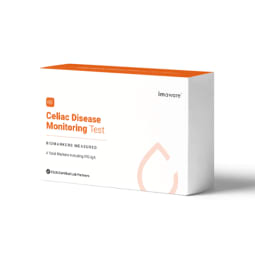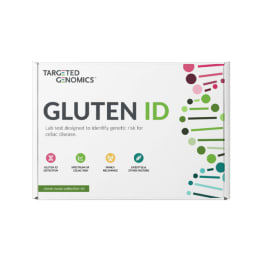Advertisement
The 4 Best Home Celiac Tests Of 2023 + Symptoms Of Celiac Disease



Celiac disease is an autoimmune disorder that affects genetically susceptible people. When a person with celiac disease ingests gluten, it triggers an immune response that damages the lining of the small intestines. The best home celiac tests help patients and physicians identify this condition, so appropriate treatment can be started.
Although a few symptoms are similar, celiac disease is not the same thing as a gluten intolerance. While gluten intolerance also causes short-term bloating and pain, it doesn't commonly lead to the same long-term harm celiac disease can. People with gluten intolerance may experience symptom improvement over time, while those with celiac disease find they are unable to eat gluten for the rest of their lives.
Without proper diagnosis, people with celiac disease could suffer from malabsorption. This means the small intestine is unable to appropriately absorb nutrients from the food a person eats. Even when a person with celiac disease eats enough food, they may be malnourished because their body can't absorb the nutrients. This is just one of the reasons why identifying celiac disease is critical. The below tests help give key insights into your health from the comfort of your own home.
What is an at-home celiac test?
At-home tests should never fully replace visits to your doctor. Instead, the purpose of at-home celiac testing is to help inform next steps with your primary care provider. Many times, a physician will prescribe multiple tests to confirm celiac disease. The best home celiac tests offer information about the possibility of a celiac diagnosis.
What is celiac disease?
Celiac disease only develops in people who are genetically predisposed, and is estimated to affect approximately 1 in every 100 people worldwide. People with a first-degree relative who has celiac disease have a higher risk of developing the disease themselves than those whose first-degree relatives do not have the disease. For reference, a first-degree relative is a parent, child, or sibling.
Celiac disease can develop at any age—and it can lead to serious health concerns when left untreated. People who are untreated have a higher risk of developing other autoimmune disorders, such as multiple sclerosis, Type 1 diabetes, anemia, infertility, and neurological conditions. Even after diagnosis, celiac disease increases the risk a person can develop coronary artery disease and small bowel cancer.
Symptoms of celiac disease
Many symptoms of celiac disease are related to the digestive system. These symptoms commonly include chronic diarrhea or constipation; pale, bad-smelling stool; gas and bloating; weight loss; and stomach pain. More than half of adults diagnosed with celiac disease have systemic symptoms.
Common systemic symptoms:
- Dermatitis herpetiformis: A chronic skin condition characterized by intensely itchy skin with small clusters of blisters and bumps
- Osteoporosis or osteomalacia, which is loss of bone density or bone softening
- Anemia caused by iron deficiency, when the body cannot absorb iron
- Mouth ulcers, headaches, and fatigue
- Hyposplenism or reduced function of the spleen
- Nervous system dysfunction, including problems with balance, cognitive impairment, and numbness in the feet or hands
- Slow growth patterns in children with celiac disease
What foods should you avoid with celiac disease?
Currently, the only treatment for celiac disease is a strict, lifelong gluten-free diet. Gluten is found in wheat, barley, and rye along with other grains.
Foods to avoid:
- Bulgar
- Durum
- Farina
- Graham flour
- Malt
- Semolina
- Spelt
- Triticale
- Wheatberries
- Emmer
- Farro
- Einkorn wheat
- Brewer's Yeast
- Wheat starch
People with celiac can have a reaction after eating something as small as a crumb of toast. Gluten can hide in medications, foods, and nonfood products when they are manufactured in plants where gluten is also present. For example, lipstick, toothpaste, nutritional supplements, prescription and over-the-counter medications, playdough, and envelope and stamp glue may contain gluten.
Wendie Trubow, certified functional medicine practitioner and president of the National Celiac Association, recommends making "gluten-free safety nonnegotiable and consider making the home gluten-free since shared spaces often expose the celiac individual to levels of gluten that will not allow them to truly get healthy."
Per Trubow, using a health log (paper or electronic) can be extremely helpful to track your lifestyle and health changes.
How does a home celiac test work?
There are two types of home celiac tests: antibody testing and genetic testing.
Antibody tests use a blood sample to check for antibodies that have a known association with celiac disease. An antibody is a protein produced by the immune system in the presence of celiac disease. Celiac antibody tests evaluate the presence of specific antibodies that are found at high levels only in people who have celiac disease.
Genetic celiac tests evaluate the presence of a genetic marker associated with the presence of celiac disease. However, even when a person has this genetic marker, they may not develop the symptoms of celiac disease—this is not a diagnostic test. A genetic test will instead give you a better idea of how likely you are to develop celiac. The definitive diagnostic test is an EGD (endoscope) and biopsy. Before completing this test, you will be asked to eat a specific amount of gluten, for the most accurate results.
A person's primary care physician may request they use a home celiac test to guide subsequent testing and determine the origin of a person's symptoms. Typically, the first test is an antibody blood test, after which a physician may follow up with an upper endoscopy. If the antibiotic tests are negative but symptoms persist, genetic testing may be used to rule out celiac disease.
Who should use a home celiac test?
A person with symptoms of celiac disease, or with a relative who has been diagnosed, may want to take an at-home celiac disease test. Since the disease is genetic, which means it runs in families, a first-degree family member with the disease may increase your risk significantly.
If you do choose to use an at-home celiac test, it's important to discuss your results with a health care professional to determine whether further testing is necessary.
Home celiac tests are not appropriate for people with mild symptoms of gluten intolerance, those who have a diagnosis of celiac disease, or those whose symptoms are so severe they should begin working with a physician immediately.
When to see a doctor
While awareness of the disease has risen, celiac disease is often confused with non-celiac gluten sensitivity or a wheat allergy. The symptoms are similar, but the course of care differs dramatically.
People with celiac disease should see their doctor when diarrhea or other digestive symptoms last for more than two weeks. Children with celiac disease should be evaluated when they are irritable, fail to grow within normal limits, or present with a pot belly and foul-smelling stools.
Trubow believes the diagnosis is truly a wake-up call and a red flag that the body is out of balance and struggling. She has seen many patients take the opportunity to transform their health and well-being.
How accurate is a home celiac test?
Experts estimate that up to 83% of people with celiac disease are undiagnosed1 or misdiagnosed with other gastrointestinal issues.
Getting tested at home is a convenient, more cost-effective, method. What's more, the results are reliable and accurate. Just note, for the test results to accurately represent your health condition, you must be eating gluten at the time you take the test. After receiving your results, be sure to schedule time with your physician to determine whether further testing is needed.
How to choose a home celiac test
Before choosing an at-home celiac test, consider test accuracy, cost, and the time it takes to receive the results. Ultimately, the best home celiac test is one that fits in your budget and will give you accurate results in a timely fashion.
How we picked:
Cost
While at-home testing is convenient, it should also be cost-effective to make sense. These options offer the greatest accuracy for the price.
Accuracy
It is important to share your test results with your physician on your path to an accurate diagnosis. This should start with accurate test results.
Results Time
No one likes waiting for results, so we choose tests with fast and accurate turnaround times.
Ease of Use
At-home testing should have clear, easy-to-follow instructions to reduce the chance there may be user error that affects the results.
Our picks for the best home celiac test of 2023:
Pros:
- Tests for 4 autoantibodies and antibodies and results within 10 business days
- Detailed reports are provided on a secure website
- FSA and HSA cards are accepted
Cons:
- Test is promised in 10 days but some customers receive it later
- Results are sometimes “inconclusive,” but the company offers a second test to confirm
Results time:
10 business daysTests for:
Measures four biomarkers to screen for celiac disease - DGP IgG, tTG IgG, DGP IgA, tTG IgACollection method:
BloodFinger stickInsurance accepted:
The company does not bill insurance but provides a paid receipt for individuals to submit to insurance for reimbursement.Imaware does not offer genetic testing, but has a cost-effective comprehensive antibody test. The test is more affordable than other options, and offers more information than a standard genetic test. Before testing, you must have been eating gluten regularly for six to eight weeks (at least two crackers per day). People with significant issues eating gluten will likely find this challenging. If you’re unable to consume this amount of gluten, skip the home testing and speak to your healthcare provider.
The brand also offers celiac monitoring tests for people who have already been diagnosed. This helps determine whether biomarkers are declining, and measures the effectiveness of a gluten-free diet over time.
Pros:
- Easy to read results
- Follow-up phone call by a nurse to review the results
- Responsive customer service
Cons:
- The test can only be done Monday through Thursday and mailed the same day
- Must be eating gluten for at least six weeks
Results time:
Within 5 business daysTests for:
Two antibodies - Tissue Transglutaminase (tTG) and Endomysial Antibodies (EMA)Collection method:
Finger stickInsurance accepted:
No, but they accept many FSA and HSA accountsLetsGetChecked sells a wide range of tests, with all results reviewed by a team of board-certified physicians. The samples are sent to a CLIA-approved and CAP-accredited lab. The collection kits are manufactured in an accredited facility.
The company uses technical and organizational measures to secure consumer confidentiality. This particular finger-stick test should be completed first thing in the morning to ensure enough time to mail the sample on the same day. A prepaid shipping provided.
Read more about my experience with LetsGetChecked test kits.
Advertisement
Pros:
- Accurate, non-invasive at-home genetics testing for at-risk family members
- You can eat gluten or be gluten-free, it does not affect the results
- If there is not enough DNA to run the test, you receive a second test free of charge
Cons:
- There is no follow-up with a medical professional if the test is positive
- Not available in NY, NJ, RI, or MD
Results time:
Up to three weeksTests for:
Variants associated with two genes - HLA-DQA1 and HLA-DQB1Collection method:
Cheek swabInsurance accepted:
NoThis test uses qualitative genotyping to detect relevant genetic variance in the DNA of adults to identify and interpret the risk for celiac disease. It is the only at-home genetic test that identifies 14 of the genetic combinations associated with the risk of celiac disease.
Keep in mind, the test does not diagnose celiac disease—nor does it describe the overall risk of developing the disease. You will not learn about your current state of health, but can use this information to help inform next steps with your medical professional.
To that end, the brand recommends consulting with your healthcare professional if they you a first-degree family member with celiac disease and are concerned you may have celiac disease. People with positive results should seek genetic counseling to help answer questions and make informed choices about diet and lifestyle. A genetics counselor can also help you understand your results and how they might impact future family planning.
Pros:
- Tests all HLA genetic variants associated with increased risk of celiac disease
- Accurate results on a gluten-free diet or eating gluten
Cons:
- More expensive than most other tests
- No follow-up care is provided
Results time:
3 daysTests for:
Genetic variants in DQ2, DQ8, HLA-DQA1*05, HLA-DQB1*02, and HLA-DQB1*0302Collection method:
Cheek swabInsurance accepted:
NoGenovate provides genetic testing for other health concerns, including those involving paternity and maternity testing. While it is the most expensive test on our list, results are ready in just three days. Some argue genetic testing is not necessary, but it does offer a healthcare provider more information when a first-degree relative has been diagnosed with celiac disease.
Remember, not everyone who is genetically positive has celiac disease. This test cannot diagnose celiac disease so it is crucial consumers receive counseling from their healthcare provider if the test is positive.
All testing is done in a laboratory certified by the American Association of Blood Banks, the College of American Pathologists, and the CLIA.
Advertisement
FAQ:
Is there a rapid test for celiac disease?
Bohit Healthcare has a 10-minute celiac quick test for use in pharmacies, outpatient clinics, and doctor's offices. The test looks for the presence of antibodies and requires a test reader.
What are the 4 markers for celiac disease?
There are several endoscopic markers described for celiac disease, which are visual landmarks a gastroenterologist may identify during an endoscopy. These are atrophy of the intestinal lining, mosaic appearance, fissures, and loss or reduction of intestinal folds.
What does undiagnosed celiac feel like?
Left undiagnosed and untreated, even very small amounts of gluten can trigger painful digestive symptoms such as diarrhea, constipation, gas, bloating, and stomach pain. Other potential symptoms include anemia, dermatitis, mouth ulcers, and problems with balance or cognitive impairment.
Can you test positive for celiac if you are gluten-free?
At this time, there are no tests that you can use for celiac disease without eating gluten.
The takeaway
When undetected, celiac disease can cause a slew of medical issues. The best at-home celiac tests help you take your health and well-being into your own hands. While it's not a diagnostic method, at-home celiac testing can help guide next steps with your medical provider. For more home testing suggestions, check out our guides to the best at-home microbiome tests, vitamin D tests, and metabolism tests.






















